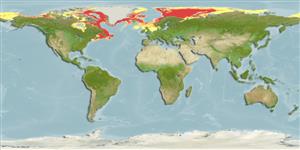Environment: milieu / climate zone / depth range / distribution range
पारिस्थितिकी
समुद्री ड़िमरसल; गहराई सीमा 25 - 1187 m (Ref. 58426). Polar; 84°N - 42°N, 180°W - 180°E
Arctic: Arctic Alaska, Smith Sound, northwest Greenland, Kara Sea, Barents Sea, off Spitsbergen, coast of Norway, Wyville-Thomson Ridge, Iceland, northeast Greenland, and localities off western Greenland.
आकार / वज़न / Age
Maturity: Lm ? range ? - ? cm
Max length : 44.5 cm SL पुल्लिंग / अलिंग; (Ref. 11976)
Benthic; feeds on crustaceans (Ref. 58426). Switches feeding habits with increasing size. Smaller eelpouts eat mainly endobenthic prey, larger individuals feed more on epibenthic prey (Ref. 13532).
Life cycle and mating behavior
परिपक्व अवधि | पुनरुत्पत्ति | मछलीऔ का अंडे देना | अंडे | Fecundity | लार्वा
McAllister, D.E., M.E. Anderson and J.G. Hunter, 1981. Deep-water eelpouts, Zoarcidae, from Arctic Canada and Alaska. Can. J. Fish. Aquat. Sci. 38(7):821-839. (Ref. 11976)
IUCN Red List Status (Ref. 130435)
Threat to humans
Harmless
Human uses
अधिक जानकारी
आम नामउपशब्दचपायचयपरभक्षीईकोटोकसीकोलौजीपुनरुत्पत्तिपरिपक्व अवधिमछलीऔ का अंडे देनाSpawning aggregationFecundityअंडेEgg development
संदर्भजलीयकृषिजलीयकृषि रूपरेखाखींचआनुवंशिकीElectrophoresesहैरेटिबिलटीबीमारीप्रक्रमणNutrientsMass conversion
सहयोगीयोतस्वीरेStamps, Coins Misc.ध्वनिसिगुयटिरारफ्तारतैरने के प्रकारगिल क्षेत्रOtolithsदिमागदृष्टि
साधन
Special reports
Download XML
इंटरनेट स्रोत
Estimates based on models
Preferred temperature (Ref.
123201): -0.9 - 4, mean 0.8 °C (based on 1789 cells).
Phylogenetic diversity index (Ref.
82804): PD
50 = 0.5000 [Uniqueness, from 0.5 = low to 2.0 = high].
Bayesian length-weight: a=0.00251 (0.00156 - 0.00403), b=3.21 (3.07 - 3.35), in cm total length, based on LWR estimates for this species & Genus-body shape (Ref.
93245).
Trophic level (Ref.
69278): 3.5 ±0.50 se; based on food items.
लौटाव (Ref.
120179): बहुत नीचे, न्यूनतम जनसंख्या दुगनी समय अवलागत 14 महीने। (Preliminary K or Fecundity.).
Fishing Vulnerability (Ref.
59153): Moderate vulnerability (42 of 100).
